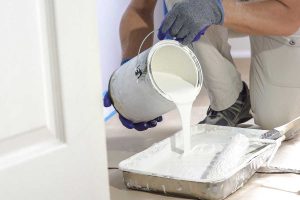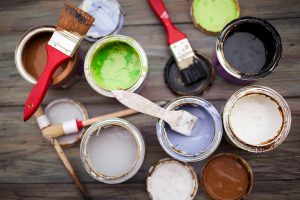We know that painting over semi-gloss paint with a lower sheen, like satin, can end up in disaster without proper prep work. But would the paints be more forgivable if you layer over an eggshell finish over satin?
To understand how each paint works, we’ll break down their formulas and differences below. We’ll also give you tips on painting over satin with eggshell paint so you get the most flawless finish. If you’re ready to transform your house, read more below.
What is satin paint?
Satin paint is a popular choice for interior walls because of its subtle sheen. This allows light to reflect on its surface, adding more depth to a room. Its glossy sheen isn’t as intense as semi-gloss or high-gloss paints, so it’s a good middle ground for when you want to add flair to your space without making it look too bright.
Another advantage of applying satin paint to your walls is that it’s more durable than eggshell paint since its glossy finish adds an extra layer of protection against moisture. Your walls will be easier to clean since stains don’t directly sink into their sleek surface. So you can just use a damp cloth to wipe away dust, grease, or markers, and it will look good as new.
What is eggshell paint?
Eggshell paint is closer to a matte finish but still has a bit of a shine. Similar to satin, it’s a common choice for interior walls because it’s easy to apply and more forgivable for painting mistakes.
Since it doesn’t contain the same level of sheen as satin, uneven splotches won’t stand out as much. It can also easily conceal scuff marks, scratches, or dents on your walls, making textured surfaces look more flawless than they actually are.
Eggshell paint is also more affordable than satin, so if you’re on a budget, you won’t have to worry about going overboard.
Is it possible to paint an eggshell finish over satin?
Now that you know the differences between the two paints, can you paint eggshell over satin?
Professional painters recommend you sand the satin paint off before applying a layer of eggshell. Since the glossy sheen of satin will make it difficult for eggshell paint to adhere to the surface. Even if the eggshell layers over easily, it won’t last as long as you expect since it will start to chip or peel off.
When you’re choosing eggshell paint, you should also match it with the same formula as satin since using oil-based paint over water-based formulas won’t go well. It can either crack, paint, or form a rubbery texture that you can pull off. Although you’ll be sanding off the old paint layer, it still won’t hurt to make sure.
If you’re not sure what the formula of the satin paint is, you can rub a piece of cloth or cotton ball that’s doused with rubbing alcohol on a small spot on your wall. If the paint softens and transfers to the cloth or cotton ball, it’s water-based paint since alcohol doesn’t affect oil-based formulas.
How do you paint over a satin finish?
To apply eggshell paint over a sating finish properly, follow the steps below:
- Use sandpaper to remove the old satin paint from the walls. You can start with a 60-grit sandpaper and adjust to a rougher or higher-grit one if you want a smoother surface.
- Once you’re done sanding, wipe away any dust on the walls with a damp cloth. You can also remove stubborn stains with a mild soap so you can work on a flawless surface.
- Repair any holes or cracks with spackling or joint compound, and let them dry completely.
- Sand your walls again to remove any rough textures from the patched spots on the walls. Don’t forget to wipe away any dust from sanding.
- Place painter’s tape on the trims, light fixtures, and switches to ensure you won’t get paint on them. This also ensures you get a straight edge when painting areas near trims.
- Apply 1-2 coats of primer on the walls to fill in uneven spots and ensure the paint adheres better.
- Once the primer is completely dry, apply 1-2 coats of the eggshell paint, making sure to let each coat dry completely before applying the next one. Let them dry completely, and you’re done!
Can you paint over satin without sanding?
If you’re running on a schedule and won’t be able to sand the walls, there is a risky way of directly applying eggshell paint without sanding the old coat.
To do this, you’ll need to clean your walls with sugar soap. It’s a cleaning solution for removing grease, dirt, and nicotine stains on any painted surface. Its liquid solution has a gritty texture that helps remove stubborn grime.
After cleaning, you must apply an adhesion-promoting primer to help your eggshell paint stick better on the walls. One to two coats should be enough, and remember to let each layer dry completely before applying the next one.
When should you not use eggshell paint?
Even if you follow all of the right steps for painting over satin paint, your eggshell walls won’t be able to last long if you paint it on certain areas of your house.
Since it doesn’t have the same glossy finish as satin, moisture can easily penetrate it – resulting in mold and mildew. So it’s best not to apply it on humid areas of your home, such as the bathroom, laundry area, and house exterior. Instead, it will hold up better in your living or dining rooms since they’re usually away from moisture.
Need help with painting your home?
If you need help painting over satin with a brand-new eggshell finish, let Soho Painters assist you. They have a team of experienced painters equipped with the best tools, materials, and training to provide you with professional results. They also offer exterior, apartment, and commercial painting to cover your home makeover needs. For questions or inquiries, contact their team now and book a free estimate.





